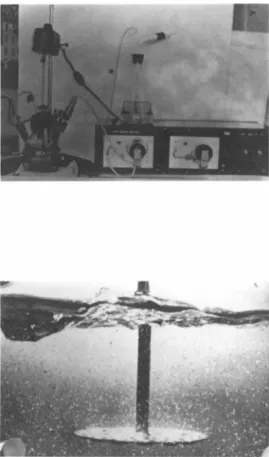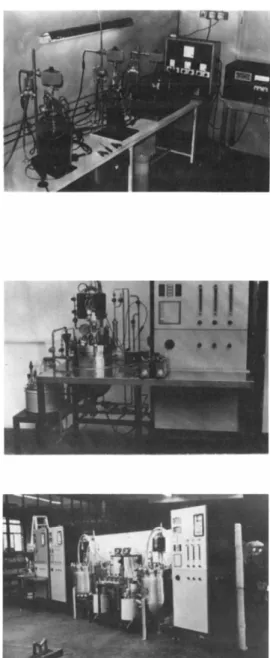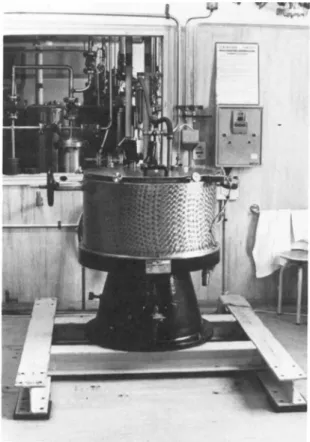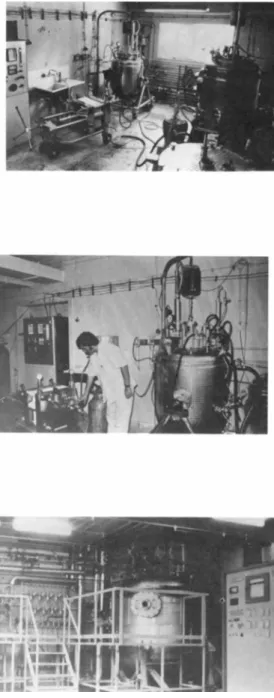Foot & Mouth Disease Institute Ankara, Turkey
I. INTRODUCTION
Prophylaxis against Foot-and-Mouth Disease (FMD) in countries where the disease is enzootic is mainly based on systematic and periodic vaccination of the entire livestock.
Production of Foot-and-Mouth Disease vaccine requires a large quantity of FMD virus. This quantity is all the more huge since FMD vaccines are generally polyvalent to face the numerous types or sub-types of the virus.
A new era in this production opened in 1962 when successively;
- Mac Pherson and Stoker at the Glasgow Institute of Virology isolated the Baby Hamster Kidney (BHK) cell line.
- Mowat and Chapman at Pirbright virus disease laboratory showed the receptivity of BHK cell to FMD virus.
- And still during the same year when Capstick, Telling, Chapman, Stewart, also at Pirbright laboratory, adapted the BHK cell to suspension cultures.
Ill
However, it was only in 1967 that Brescia FMD Institute in Italy with Ubertini, Nardelli, Dal Prato, Panina, Barei started BHK suspended cell cultures for large scale production.
During this lapse of time 1962-1967, various studies were carried out. They were mainly undertaken at Pirbright. They dealt with all factors affecting the production of FMD virus such as the culture vessel, pH control, cell concentration, the cul- ture medium, the oxygen consumption and so forth. These studies provided the basic elements for the extension of large scale plants concerning BHK cell, and FMD virus production.
Indeed, since 1967 large scale plants have developed through- out the World, either under private organizations or under Govern- mental Institutions, Today England, Italy, Germany, Spain, Den- mark, France as well as various countries in South America can exhibit industrial plants.
Personally I started in 1969 to assist under United Nations support, some developing countries in applying these techniques.
I continued in 1972, establishing a pilot plant able to produce 10 million doses of vaccine and today I am in charge of organiz- ing a plant able to grow 500,000 litres of cell cultures per year.
Last but not least, in the University of Alabama, Lynn and Acton established a suspension culture pilot plant to process Mammalian cells and, on a broader angle, people are now turning to the large scale production of biomass through the production of a single cell protein such as yeast and bacteria which empha- size the fermentation technology.
II. INDUSTRIAL PLANT
There are no doubt many solutions for establishing a large scale plant for cell production. They depend on the purpose and the scale of the production, on architectural, geographical, in- dustrial, and biological conditions, not to mention hazard and
ing countries must not be too computerized, because maintenance of automatic machines is sometimes difficult!
In any case, the equipment at my disposal can undertake sus- pension cell culture from the laboratory to the industrial scale,
from 1/2 litre to 3000 litres. After various trials we now pre- fer the use of vibrofermenters1 which deserve a short description.
A νihrofermenter is a container of differing capacities built in glass or in stainless steel according to the volume; either spherical or with a hemispheric bottom and equipped with a vibromixer.
The vibromixer is composed of a stirrer and a vibrator.
The stirrer is a round stainless steel plate or disc fixed along a shaft vertically positioned. This disc is perforated with conical holes. The orientation of these cones determines the direction of the agitation and the flow runs towards the top of the cone in the same way as lava is ejected from a volcano.
The stirrer can therefore be installed with the narrow ends of the holes pointing upwards to direct the main flow towards the surface of the liquid. In the reverse, the top of the cones pointing downward, directs the main flow towards the bottom of the fermenter. Naturally, stirrer discs are of different sizes which within certain limits must be adapted to the diameter of the container. In special cases, two stirrers in reverse posi- tion can be installed on the same shaft. For sterile work, on a laboratory scale, the shaft is fitted through an absolutely air- tight sealing membrane assembly, inserted in a rubber stopper in the neck of the glass vessel. On a large scale, in a closed fer- menter, a flanged membrane fitted to the shaft is inserted at the top of the vessel.
Vibromixer & vibrofermenter are trademarks of CHEMAP AG, Maennedorf, Switzerland. Exclusive distribution in the United States of this equipment by Chemapec, Inc., 1 Newark Street, Hoboken, New Jersey 07030.
The vibrator is an electromagnetic power-unit causing vertical vibration. These vibrations are generated at the frequency of the alternating current supply: 60 cycles in the U. S., generally 50 throughout Europe. Moving the stirrer plate up and down in a liquid creates pressure differences in the tapered holes causing the liquid to stream through continuously. Naturally the ampli- tude of the stirrer is adjustable from nearly nothing to a maxi- mum of about 3 mm thanks to a variable transformer or an electric
"tyristor.11
We illustrate these brief descriptions in Figs. 1-11, which show the scaling up of some installations.
FIGURE 1 One of the first laboratory "VIBROFERMEN- TERS" as it was described in 1965. The Fermenter consists of a glass balloon with jacket for tempera- ture control.
FIGURE 2 Ά "VIBROMIXER"
in action. The even dis- tribution of particles with a smooth turbulence on the surface is
noticeable.
FIGURE 3 The laboratory
"VIBROFERMENTER" in sizes 0.5, 2 and 6 Liter made from reinforced glass are connected to a panel where pH, temperature and oxygen supply is controlled.
FIGURE 4 A 30 Liter
"VIBROFERMENTER" with all its accessories, built for sealing up of the produc- tion.
FIGURE 5 Two 100 Liter
"VIBROFERMENTERS" with control panel and water heater.
FIGURE 6 Our Cell Centrifuge with a flowmeter of 600 L/hour.
FIGURE 7 Ά 400 Liter "VI- BROFERMENTER" installed at the FMD Institute in Padovaf Italy.
FIGURE 8 Perhaps an under- developed Installation with its rubber connections - J b u t
producing 400 Liter of cells 3 times a week with Mixer for medium preparation, Filter, "VIBROFERMENTER,"
continuous cell Centrifuge and control panel.
FIGURE 9 This 400 Liter
"VIBROFERMENTER" is con- nected to a "SEITZ" Filter for medium supply.
FIGURE 10 Ά 3000 Liter Fermenter with air/CO2, pH and temperature control.
FIGURE 11 Ά view of the "VIBROMIXER" stirrer installed in the 3000 Liter "VIBROFERMENTER."
III. PROBLEMS RAISED BY LARGE SCALE PRODUCTION
Figures 1-11 show that fermenters to ensure continuous cell cultures can be equipped as required with steam sterilizable pH electrodes, dissolved oxygen electrode, temperature probe, vari- ous sterilizable filters, reflux cooler, air incinerator, light and view ports, steam sterilizable sampler, solenoid valves for the regulation of various fluids, electronic devices to measure the medium needed, and additional openings for medium distribu- tion, cell collecting, etc. Since engineers, bioengineers as well as microbiologists have given all their attention to the design of large scale suspension cultures facilities, many prob- lems of cell growth have been elucidated and it is not my inten- tion to recall them. I shall elaborate only on certain problems with which I have had to deal as a user.
First of all I shall give the reasons for prefering the vi- brating form of agitation. I have used, and occasionally still do at the laboratory scale a magnetic stirrer, both Belco type and mainly Pirbright type, at the intermediary scale the impeller and the slow up and down movement of a large plain disc as in cattle tongue epithelium culture and at the large 'scale the Arch- imedean screw and the turbine wheels. With most of these means of agitation BHK cell growth was obtained. On the other hand my very first trials with a laboratory vibrofermenter made me sus- pect that this type of agitator produced mild shock waves in a similar way to an ultrasonic machine. But very quickly further trials demonstrated and regularly confirmed that the vibromixer, like any stirrer, either magnetically coupled or mechanically driven, can be regulated for suitable agitation. And as the vi- bromixer is capable of many variations in mixing any substance from which its universal use stems, several factors must be taken into consideration for regulating it properly. Among these, the diameter, the position and the location of the plate, and above all the amplitude adjustment of the stirrer give a solution to any problem of agitation. Once this agitation was regulated, we experienced at any level of the production, all other conditions being similar, that the cell production either in yield or in morphology was always better than those obtained with any other types of stirrers. Aggregates and cell clumps as well as low yield were a common lot at one period of our work when we were unfortunately experiencing water or serum of low quality. During this difficult phase we invariably noted the advantage of the vi- brating system of agitation from the standpoint of cell growth, morphology and the dispersion of the cells produced. This fact is very likely due to a better air exchange since the suspension constantly crosses the air medium interphase. Moreover in FMD virus replication it was noted that a stronger agitation promoted
the dislocation of the cells and released the virus, thus enabling a shortening of the process of producing high parameter virus.
Our experiments have been ongoing for several years.
In Alabama, Lynn and Acton have found that the vibrating disc could be equally as good as the spinner flask for cell growth, but that the expression of particular cell surface components was reduced. Hence, their results at least confirm ours on the im- portance of the agitation system.
Two other items still deserve some comments; the supply of oxygen and the pH regulation. Concerning the supply of oxygen, we entirely adhere to the conclusion of Radlett, Telling, Whit- side and Maskell: "if a steam sterilizable dissolved oxygen elec- trode is useful, it is not essential for routine cultures once the oxygen solution rates obtainable in the vessel and the oxygen demand of the cells are known." About the pH, experience has shown that BHK can easily grow in an acid environment. Basic pH beyond 7.6 is more detrimental to cells than a slightly acid, pH 6.6. However, pH 7.2 is the most suitable for correct growth.
To some extent, surface air can compensate the development of acidity consecutive to cell metabolism and noticeable with high cell concentration. In this way the agitation system plays a major role. This fact is particularly apparent at the beginning of the virus replication. Nevertheless, sparged air must be used to satisfy oxygen demand. As it was shown that excessive sparg- ing could be detrimental to cell growth, air distribution is en- sured not continuously, but alternatively.
B. Biological Problems!
Many factors influencing the growth of BHK suspended cells and the replication of FMD virus on these cells have already been described. But it is also known thatmost of the Institutes deal- ing with the same production were paralyzed for months at a time
and sometimes repeated failures that I now turn,
I shall deal with, waterf steam, and serum. I must also empha^
size the problems of BHK cell behavior and above all of FMD virus replication.
1. Water
It may seem trivial to tackle such a problem, but the condi- tions encountered in developing countries are very different from those found in developed countries, although pollution is now a general problem with which the world is concerned.
For years the water used in Ankara FMD Institute was extracted from a well. This raw water was distilled at the beginning.
Later on, with the development of cell production, this distilled water was insufficient in quantity and a plant for water deminer- alization was installed. For a long time distilled or déminerai- ized water seemed suitable for cell development. A preliminary warning appeared sometime in 1972: after a heavy storm, the raw water was noted to contain fine brown particles which were not retained by the resins of the columns of the demineralizer.
These particles, due to an insoluble organic substance were con- sidered detrimental to cell cultures even though they do not really affect the resistivity of the treated water. The solution, advocated by a specialist, was to pre-treat the water and floc- culate these organic substances before filtration through gravel and active carbon. But such a transformation could naturally not be carried out instantaneously and as a temporary measure after washing the resins several times, the organic substance was no longer discernible.
One and a half years later, after 24 hours of culture, BHK cells in five production fermenters were found dead for no appar- ent reason. Howeverf at this time It was noted that the resisti- vity of the démineraiized water had dropped entirely. The reason was due to a substitution of the well water by raw water from a
stagnant lake in spite of so-called previous treatment. The ef- fect of this substitution was similar to a tidal wave, everything was polluted: softener, demineralizer, boiler, piping, washer.
Even the distilled water was not satisfactory for cell multipli- cation. Two engineers were needed to regenerate the demineraliz- er. Although demineralizer and distillator were again connected to the well water, the lake water continued for some time to sup- ply the tap water and the boiler and we experienced some phenom- enon of subtoxicity, characterized either by the non development of cells or a progressive extinction of the cell through various passages.
I shall close the description of these events in spite of the fact that they stopped our production for months by summarizing the solutions retained. These were the use of demineralized water after pretreatment of the raw water for general washing, and sup- plying a distillator able to produce bi-distilled water for medi- um preparation.
2. Steam
A demonstration of the harmful action of steam was shown in the first fermenters we were given. They were built to be ster- ilized by direct expansion of sprayed steam. They had to be thor- oughly washed with sterilized treated water after normal steam sterilization if cell development was to succeed. Steam sterili- zation of fermenters through a double jacket is the only advisable process and the use of steam originating from treated water is required to sterilize filters and supply autoclaves.
3. Serum
The question of the serum is another chapter. While so much care is given to the composition of any growth medium it is still paradoxical to be obliged to add X% serum as if serum was a stan- dard product of well-defined composition.
it immediately raises problems of supply either in quantity or quality. The quantity required obliges most Institutes to harvest blood at the abattoir during slaughtering. Collecting blood from slaughtered animals creates the problem of quality. Fortunately our own experience, already based on several years, shows that FMD antibodies found in the blood do not prevent BHK cell growth and do not modify the receptivity of BHK cells to FMD virus repli- cation, although cells must be removed from medium containing serum during the virus replication. However, the quality of se- rum is seriously compromised in cattle fed with artificial food and in Italy they now use only the serum from dairy cattle since these animals generally receive natural fodder to avoid modifi- cations in milk quality and flavor.
Serum, as it is harvested in the abattoir on any slaughtered animal raises the possibility of bacterial or viral contamination and it is a very serious limiting factor. The constant threat of contamination by Mycoplasma, so difficult to detect in cell cul- tures and so tremendously heterogeneous in their metabolic activi- ties, is another concern.
Sterilization of serum by inactivation at 56°C was recom- mended but BHK cells did not proliferate with this treated serum.
Bartling, from Lelystad Institute in Holland recommends the use of polyethylene glycol to precipitate virus, microbes and anti- bodies since BHK cell growth with PEG'-serum appears to be normal.
Last but not least, the era when BHK cell cultures; will be carried out by chemicals instead of serum is now not very far away. The first hope in this area came from Tomei and Issel of Plum Island Animal Disease Center who developed BHK cells in a serum-free chemically defined medium and from Keay at Washington University who is pursuing similar studies. This ultimate solu- tion will greatly help the problems of large scale cell culture.
4. BHK Cells
I am not far from believing that each Institute finally has its own BHK cells in spite of their common origin: BHK-21 clone 13 of Mac Pherson and Stoker isolated in 1962, Indeed, according to their sources, BHK cells vary in size, shape and behavior.
When with my colleagues Okay and Kivilcim, we began our work on BHK in suspension our cells were provided by Brescia Institute Italy. Later on we received some BHK cells from Razi Institute, Teheran, Iran. It did not take long to notice different charac- teristics and. properties between them. Most of the Brescia cells, more adapted to suspension cultures, were round and multiplied extensively. Razi BHK cells were bigger in size, more elongated or polygonal with a rounded outlined shape. Several FMD virus replicate well and nearly always the first time on Razi BHK, whereas the same viruses generally require several passages to be adapted to Brescia BHK.
At one time, we had to begin again with a new master seed and we received a new batch of Brescia cells. This strain had only received 9 passages in Brescia Institute. It had come from Pir- bright Laboratory where it had been adapted to suspension. Curi- ously enough there were many similarities between these Brescia No. 2 BHK cells and the Razi cells, even in their behavior in front of FMD virus.
Another time Lelystad FMD Institute from Holland sent us their BHK cells, one of them after 74 passages in suspension, the other after 362 passages, each differing by its characteristics and properties already mentioned for Razi and Brescia No. 1, even the BHK 362 cannot grow in monolayer.
Perhaps it should also be mentioned as a reminder that the original BHK cells, the Glasgow cells, not adapted to suspension culture are of the fibroblastic type in regular spindle shape.
Thus it seems that the progressive adaptation of BHK cells to suspension culture through passages modifies their morphological
long intermediary step of polygonal rounded angle cells. It is worthwhile noting that these variations of forms are most obvious when these cells are cultivated in monolayer culture. At the last stage of adaptation to suspension, monolayer culture becomes rather difficult.
Experience shows us that at the large scale production it is better to use BHK cells recently adapted to suspension.
5. BHK Cells and FMD Virus Inter-reaction
In the course of performing routine plague assays on type Asia 1 FMD virus. Cowan from Plum Island Center with Erol and Whiteland, all working in Ankara FMD Institute found that virus grown in our BHK monolayer section (roller bottles) produced mainly large plaques whereas virus from our BHK suspended cell unit produced predominantly small plaques. This casual observa- tion led to the demonstration of different antigenic character- istics which in turn resulted in a difference of immunological properties. Vaccine prepared from the Asia 1 large plaque was found at least 3 times more effective in inducing immunity in cattle against the field virus than was a vaccine prepared from the small plaque Asia 1 virus.
Moreover Razi BHK cells grown in monolayer proved highly sus- ceptible to Asia 1 field virus but passaging of this virus re- sulted in a rather rapid change from a predominantly large plaque population to a mainly small plaque. Consequently, to produce
large plaque virus it is necessary to remain at a low passage level. On the other hand Brescia No. 1 BHK cells were not sus- ceptible to Asia 1 virus. Adaptation of this virus required a series of preliminary passages in Razi BHK during which the virus shifted toward a predominantly small plaque population. This ex- plains why the virus produced in the monolayer section using Razi BHK cells was predominantly large plaque whereas virus adapted to
submerged Brescia cells and produced in BHK suspended cell unit were small plaques. Therefore, to produce an Asia 1 virus that is mainly of the large plaque type it is necessary to remain at a low passage level of virus and used BHK cells susceptible to vi- rus infection such as Razi or Brescia No. 2 BHK cells.
It is worthwhile noting that our last findings, show that the preliminary passages of FMD field virus, mainly Asia 1, on Glas- gow BHK cells, stabilize the predominant virus population, as if they were cloned. These virus can then be replicated on BHK sus- pended cells with no other transformation at least during the first stages.
Recent studies also confirm the progressive loss of suscepti- bility to FMD virus of BHK cells following consecutive cell pas- sages. Between the 30th and 80th passage large plaque Asia 1 virus infectivity titer was reduced by 2.5 log. Concerning 0 vi- rus its behavior is entirely different. Replication on suspended Brescia or Razi BHK does not really alter the type of plaque, however it becomes smaller through passages.
In conclusion, the production of FMD virus antigenically sim- ilar to the field virus required the use of BHK cells that were not specifically adapted to grow in suspension and also the use of seed virus very close to the field virus.
Thus we can see that the problem of large scale virus produc- tion on BHK is not only a problem of quantity but also a
problem of quality.
REFERENCES
1. Barteling, S. J., (1974), Personnel communication. Consul- tantship to Ankara FMD Institute and (1974) Bull. off. Int.
Epizo., 11-12, 1243-1254.
2. Capstick, P. Β., Telling R. G., Chapman, W. G., and Stewart, D. L., (1962). Nature, 195, 1163-1164.
ference of the OIE Commission on FMD Paris 11-14 March, (1974) Bull. off. Int. Epiz., 11-12, 1271-1298.
4. Keay, L., (1975), Biotech. Bioeng., 14, 745-764.
5. MacPherson, I., and Stoker, Μ., (1962). Virology, 16, 147- 151.
6. Mowat, G. Ν., and Chapman, W. G., (1962). Nature, 194, 253- 255.
7. Lynn, D. J., Acton, R. T., (1975). Biotech. Bioeng., 17, 659-673.
8. Radlett, P. S., Telling, R. C., Whitside, J. P. and Maskell M. A. (1972), Biotech. Bioeng., 14, 437-445.
9. Tomei, L. D., and Issel, C. J., (1975), Plum Island Animal Disease Center Greenport. Biotech. Bioeng., 12, 265-178.
10. Ubertini, B., Nardelli, L., Del Prato, Α., Panina, Gl, and Barei, S., (1967). Zentr Veterinarmed., 14, 432-441.




